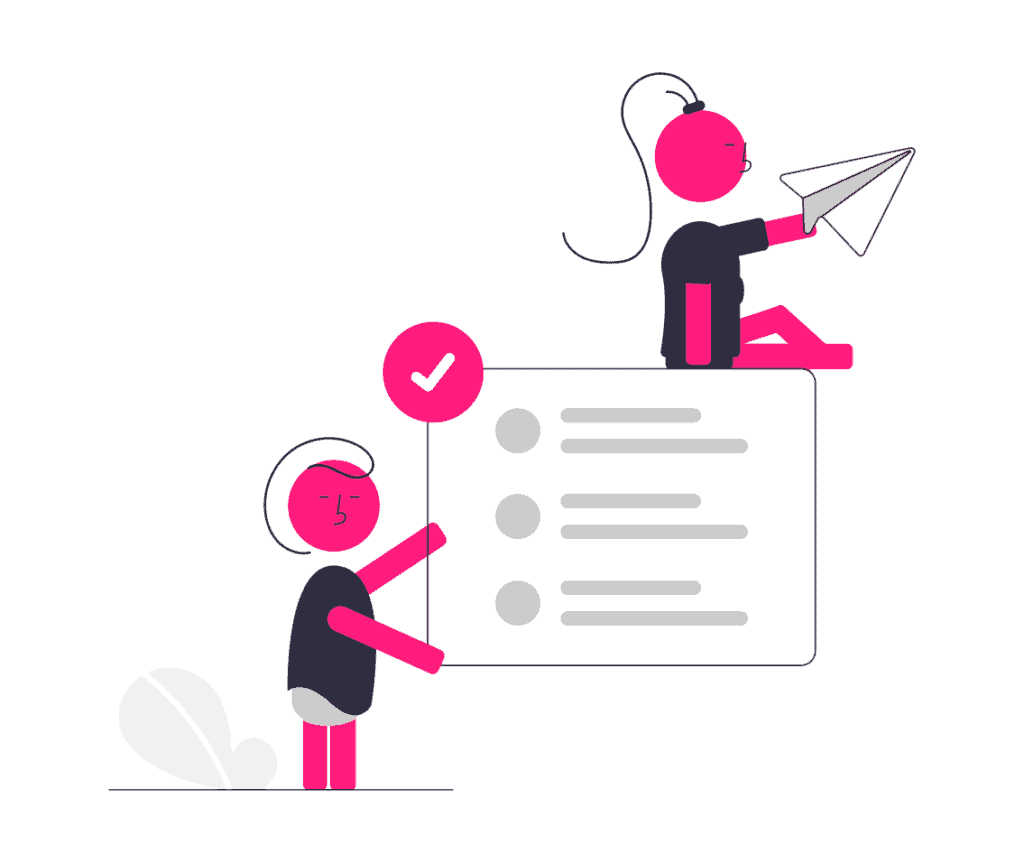Tired of giveaways ending up in the trash? Want something impactful that attendees actually use? I will show you the best choice.
The best marketing giveaway for a trade show is undoubtedly a well-designed tote bag. People reuse them often, making them walking advertisements and offering great value for your brand, turning attendees into mobile billboards for months.
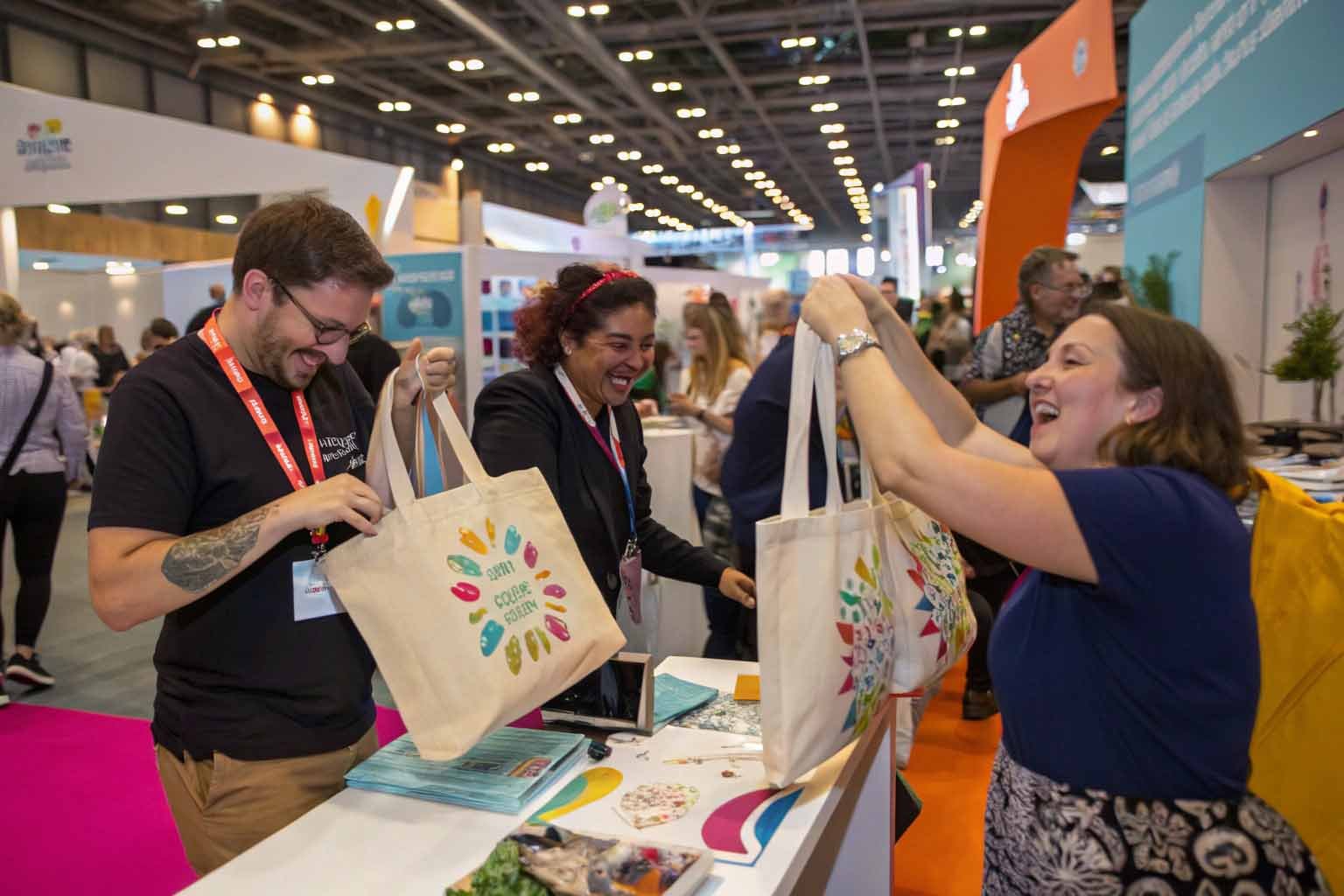
Choosing the right giveaway can make a huge difference to your trade show success. It is not just about giving something away; it is about making a connection. Let’s look closer at how to pick the perfect bag that truly represents your brand and connects with your audience. Keep reading to find out more about making that crucial choice.
What should you think about when choosing trade show bags?
Overwhelmed by trade show bag options? Unsure what factors matter most for your brand? Let us clarify the key considerations for making a smart choice.
When choosing trade show bags, think about your target audience, available materials, your budget, and the right size. These elements ensure your bag is practical, matches your brand, and helps you meet your marketing goals effectively.
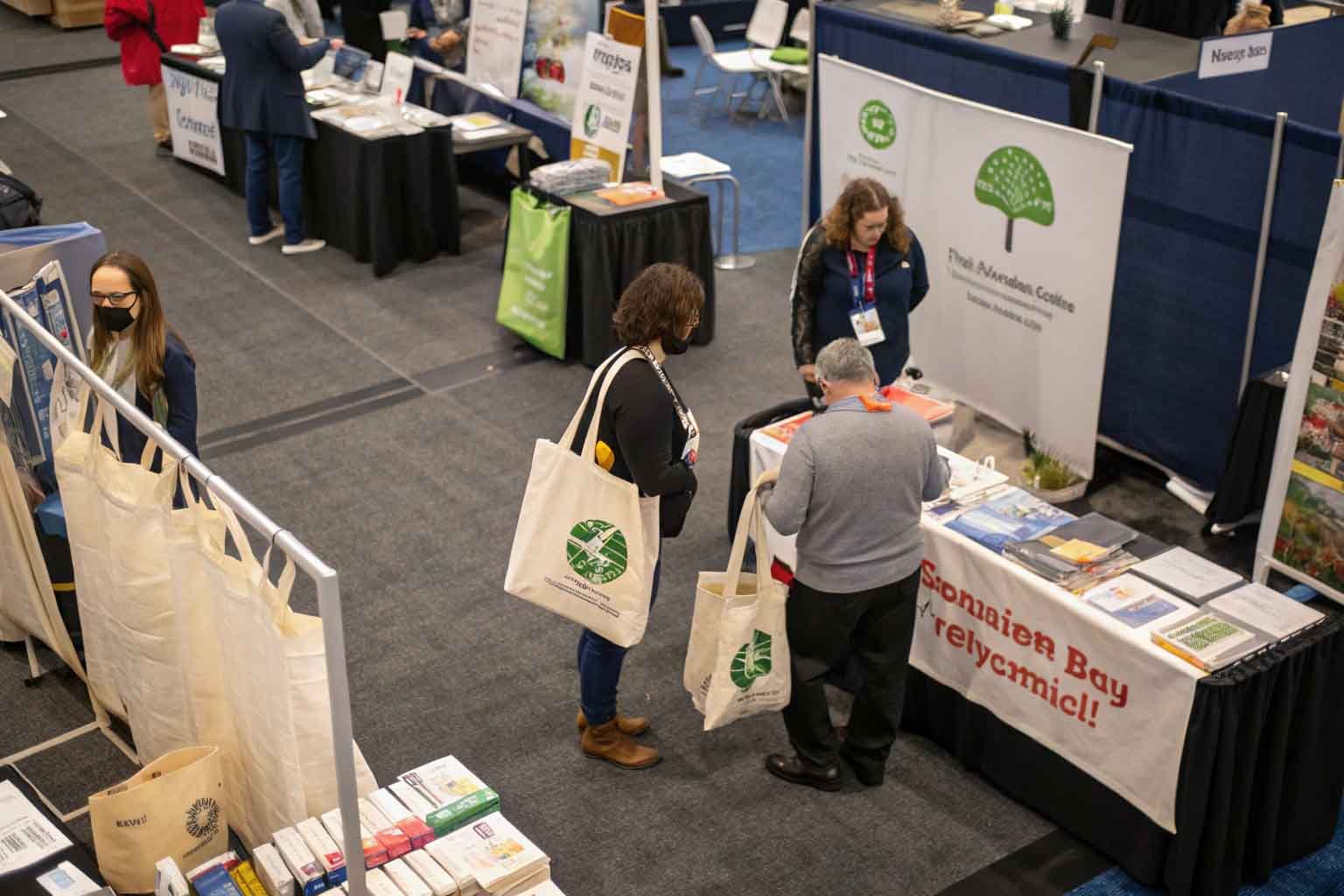
Picking the right bag involves a few important steps. It is more than just finding something that looks nice. You need a bag that works hard for your brand long after the trade show ends. I have seen many companies make choices that did not quite hit the mark, so let me guide you.
Know Your Target Audience
First, who are you trying to reach? A bag that excites tech professionals might be very different from one that appeals to an eco-conscious crowd at a green expo. For instance, if you are in a service industry without physical products, a stylish tote bag printed with your company information, perhaps with a quality notebook and pen inside, works well. I remember a financial services client who did this, and attendees loved the professional feel. If your business offers physical products, like cosmetics or food samples, then smaller drawstring bags can be perfect for distributing these items to potential clients. For sports brands, I have found that drawstring backpacks are always an excellent fit because they match an active lifestyle. Understanding your audience’s preferences and how they might use the bag is absolutely key to making a lasting impression.
Available Material Options
The material of your trade show bag says a lot about your brand.
- Cotton and Canvas tote bag: These are very popular because they are durable and seen as eco-friendly. They also offer a wide range of printing options. From my experience, 6oz–8oz cotton totes or canvas tote bags are great for most exhibitors. They often have low minimum order quantities (MOQs), sometimes starting around 100 pieces, are relatively low cost, come in many colors, and they last a long time. If your budget can stretch a bit, going for thicker 10–12oz bags is even better. These sturdier materials ensure the bag lasts longer, increasing its promotional lifespan. Some studies show an average of 14 months of use per bag, especially with reinforced stitching.
- Non-Woven Polypropylene (NWPP) tote bag: These bags are very affordable. This makes them ideal for large-scale distribution, like when trade show organizers themselves need to provide bags to all attendees. I have noticed in China, these are often the go-to choice for organizers. They offer great value for money and can be printed in many ways. and another creative non-woven tote bag for the show is the extra large crossbody tote bag ,often with laminated ,this is can hold more staffs.However, they are a plastic-based material, so they are less eco-friendly than natural fibers.
- Jute: Jute bags offer a more natural, rustic look. I find these are perfect for organic food companies or eco-focused brands that want to emphasize a connection to nature.
- Tyvek: This is an interesting material. It is very lightweight, strong, tear-resistant, and water-resistant. It has a unique paper-like feel. It can be a good choice depending on your specific customization needs and how well its modern, technical look aligns with your brand identity.
- Recycled or Organic Materials: I always encourage clients to consider these. Using eco-friendly tote bags made from recycled cotton, PET bottles, or organic cotton can significantly enhance your brand image. It strongly appeals to the growing number of sustainability-conscious attendees.
Here what I highly recommend is still cotton canvas tote bag 그리고 non-woven tote bags for trade show marketing giveaways.
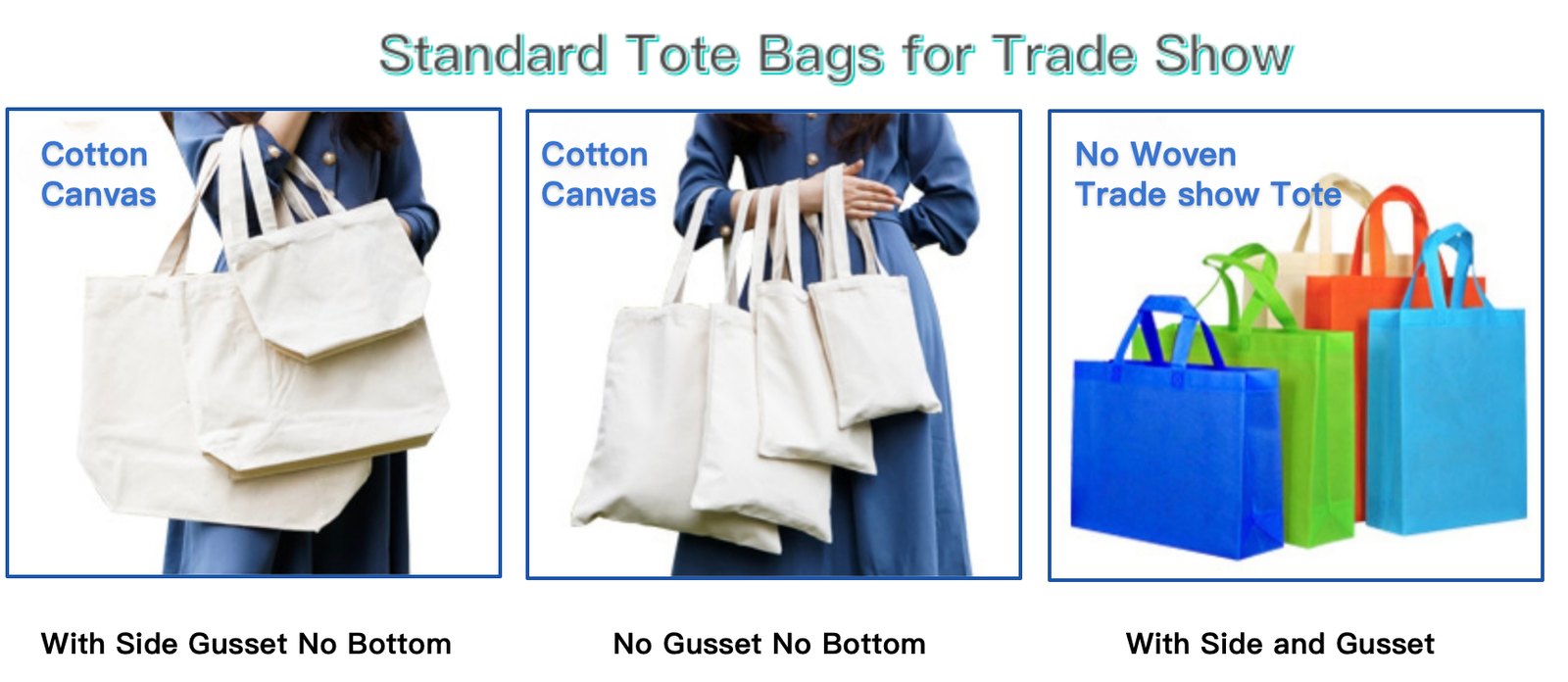
Know Your Budget
Your budget will naturally guide your material choices and any extra features.
- Generous Budget: If you have more to spend, you can explore those thicker 10-12 oz canvas tote bags. You could also consider additional features beyond the standard open-top style, like zippers, internal pockets, or bottle holders. I have even seen companies collaborate with artists or influencers on unique bag designs to add extra creative value and buzz.
- Tight Budget: If you need a large quantity of bags but have a strict budget, then non-woven tote bags are often a practical solution. The MOQ for these can sometimes be higher, maybe around 2,000 pieces if ordering directly from a larger factory, but the per-unit cost is much lower. They are significantly cheaper than other materials but still support various printing methods, so a lower budget does not mean you have to compromise too much on the visual impact.
Pick the Right Size
The size of the bag matters for usability. A commonly used and very practical size for trade show tote bags is around 35cm wide by 40cm high (that is about 14 x 16 inches), usually without a bottom or side gusset. This size is comfortable for most people to carry on their shoulder and can easily hold brochures, notepads, and other materials collected at the show. Versatile tote bags that are suitable for everyday use encourage long-term use and, therefore, extended brand exposure. You might also consider tote bags that are waterproof or water-resistant. I read an interesting statistic that these show 57% higher usage rates in varied weather conditions, which makes sense as it protects the contents.
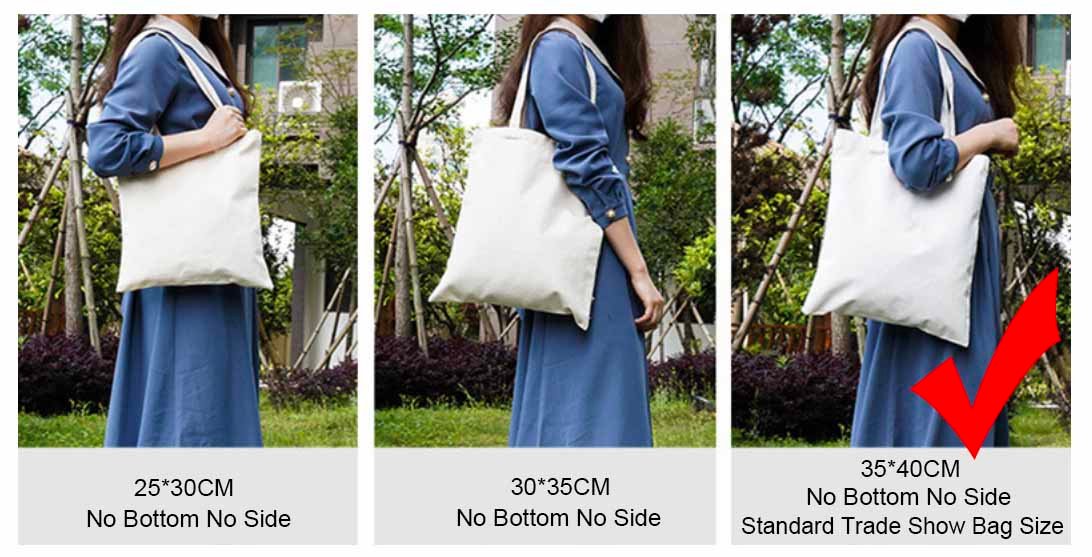
What is the best time to plan the trade show bags?
Rushing your trade show bag order at the last minute? Worried about potential mistakes or frustrating delays? I can tell you that proper planning is absolutely crucial for a stress-free and successful outcome.
The best time to start planning your trade show bags is about 2 to 3 months before the event. This timeframe allows ample opportunity for thoughtful design, efficient production, and timely shipping, ensuring your bags arrive perfectly and on schedule.
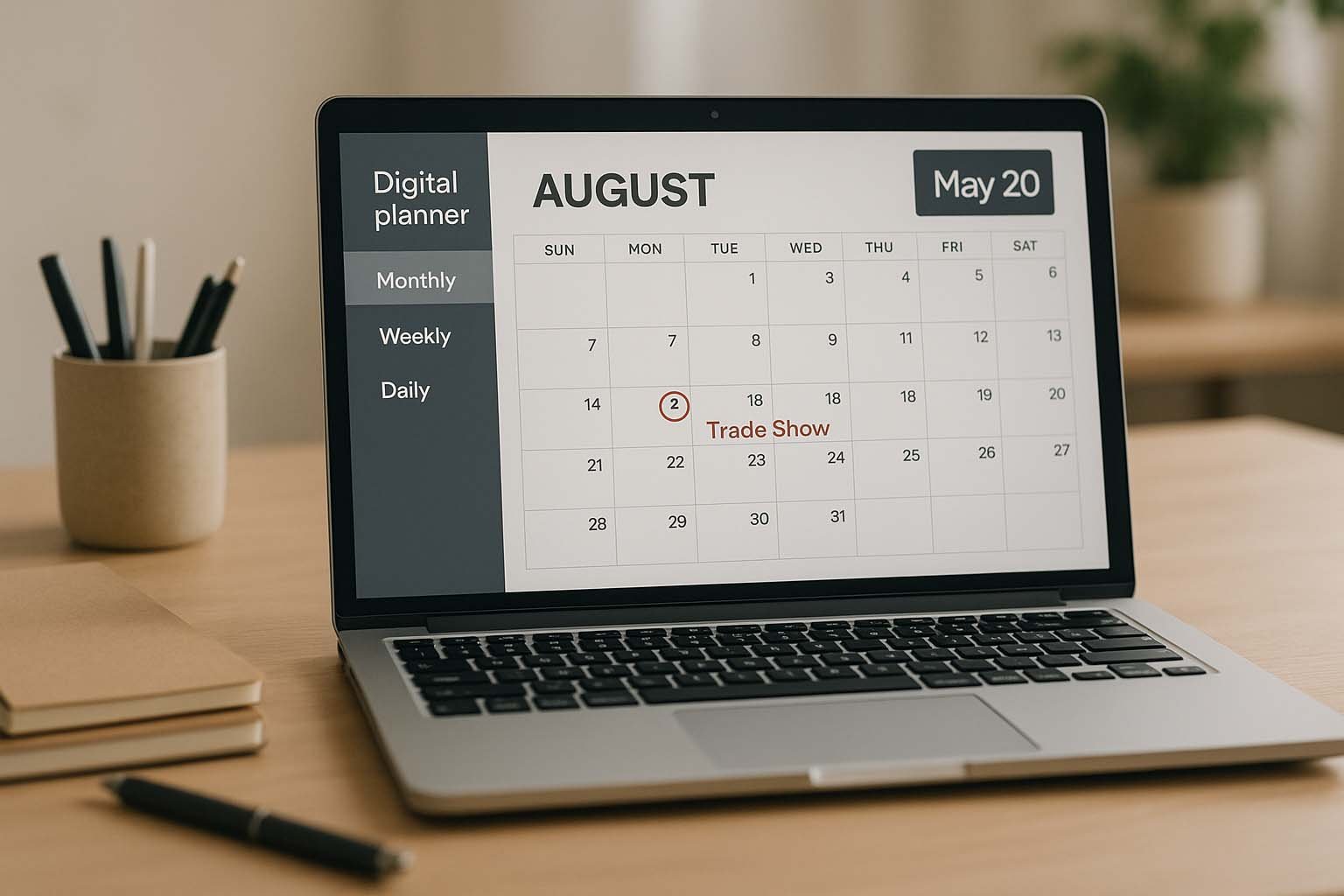
Planning ahead might seem obvious, but with so many things to juggle when preparing for a trade show, bag orders can sometimes get left until it’s almost too late. I’ve seen the panic that causes! Let’s break down why that 2-3 month window is so important.
Why Plan So Early?
I always advise my clients to start the conversation about their trade show bags at least 2 to 3 months before the actual event date. This might seem like a lot of time initially, but believe me, it flies by when you are also coordinating booth design, travel, marketing materials, and everything else. This early planning phase is vital. It ensures that your bag design aligns perfectly with your overall trade show theme and your marketing message. It gives you the necessary time to really think about how the bag can highlight the right product features and truly capture your brand’s unique essence. You do not want a generic bag; you want a bag that tells your story.
The Design Phase
The design process is more than just putting your logo on a standard bag. You need to consider the message you want to convey, the target audience we talked about earlier, and the overall aesthetic. Will the design be bold and colorful, or subtle and sophisticated? Will you include a QR code1? I have seen some compelling data that suggests including a QR code on tote bags, which links to exclusive online content or special offers, can generate up to 34% higher post-show engagement. This design process, which often includes several revisions and internal approvals, naturally takes time. Rushing it can lead to errors or a less impactful design.
Production and Shipping
Once you have finalized the design, the actual production of the bags typically takes about 15 to 25 days. This can vary depending on the complexity of your design, the material chosen, the printing method, and the quantity you order. And, very importantly, do not forget to factor in shipping time! If your event is overseas, or even if your chosen supplier is not local, you need to build in enough time for shipping. This can range from a few days for domestic express shipping to several weeks for international sea freight. Early planning helps you avoid the high costs of expedited shipping or, even worse, the nightmare scenario of not having your bags arrive on time for the show. I once had a client who ordered too late, and their bags arrived the day after the trade show ended – a costly mistake.
Pre-Event Buzz
Another significant benefit of planning and receiving your bags early is the opportunity to use them in your pre-event marketing2 efforts. Promoting your exclusive tote bags 전에 the show can build anticipation and significantly increase traffic to your booth. Imagine sending out an email blast to your prospects: "Visit our booth #XYZ at the upcoming trade show to receive your limited-edition designer tote bag!" Or you could post pictures of the bag on social media. This creates excitement and gives people an extra reason to seek you out. Some companies even send the bags to key prospects 전에 the event as part of the invitation.
How can you print your logo on trade show giveaway bags?
Confused by all the different printing options available for your custom bags? Want to make sure your logo looks sharp, vibrant, and lasts for a long time? Let us explore the best ways to make your brand truly stand out.
You can print your logo on trade show giveaway bags using various methods such as screen printing, heat transfer, or digital printing. The best choice depends on the bag material, the complexity of your design, the order quantity, and your budget.
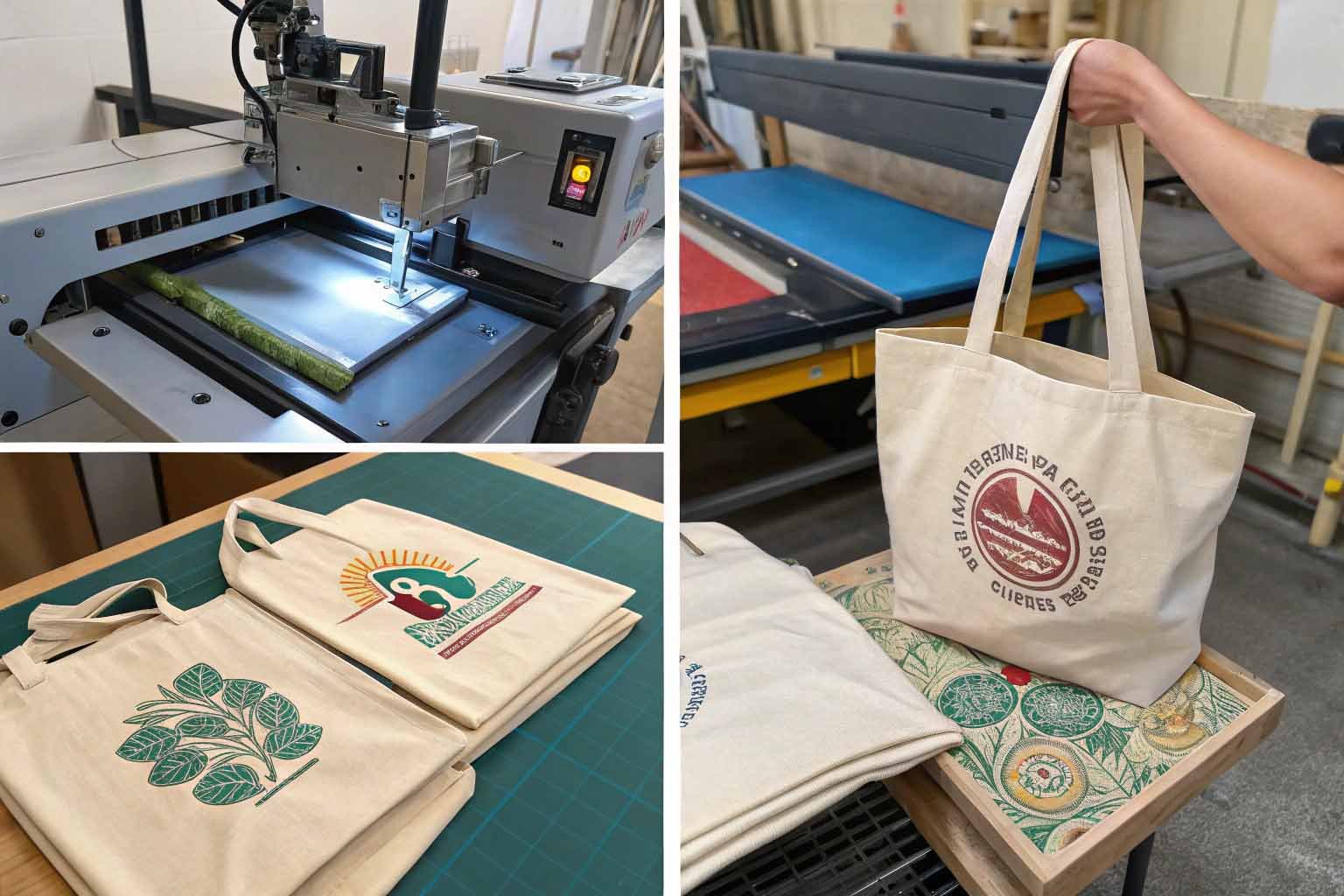
Getting your logo and message onto the bag effectively is crucial. The printing method can impact the final look, durability, and cost. Over my years in the bag business, I’ve worked with all these techniques, and each has its place.
Screen Printing (Silkscreen)
This is a very common and popular method, especially for designs that have a limited number of solid colors. It is generally quite cost-effective, particularly for larger production runs. In this process, ink is pushed through a stenciled mesh screen directly onto the fabric of the bag. It works very well on materials like cotton, canvas, and non-woven polypropylene bags. The print achieved is usually durable and can be very vibrant. For example, if you want a bold, single-color logo on 500 cotton tote bags, screen printing is often my go-to recommendation because it offers a great balance of quality and value.
Heat Transfer
Heat transfer is a great option for more complex, multi-color designs, or even for reproducing photographic images. With this method, your design is first printed onto a special type of transfer paper. This printed paper is then applied to the bag using heat and pressure, which transfers the design onto the fabric. This method is very versatile and can be used on a wide variety of materials, including some that are difficult to screen print. It is also good for smaller quantities or when you need very intricate details. However, the print might not be quite as durable as a direct screen print over the very long term, especially if the bag is subjected to frequent or harsh washing.
Digital Printing (Direct-to-Garment or DTG)
You can think of digital printing, often called DTG, as being similar to how an inkjet printer works, but designed for fabric. DTG is excellent for creating full-color, highly detailed designs, and for reproducing photographic images with many shades and gradients. It is generally best suited for natural fibers like cotton. There are often fewer setup costs involved compared to screen printing, which can make it a viable option for smaller runs, even with complex artwork. The feel of the print on the fabric is usually softer than a thick layer of screen print ink.
자수
While not technically "printing," embroidery is another popular way to get your logo or design onto a bag. It offers a high-end, textured look that many people associate with quality. An embroidered logo is very durable and looks extremely professional. Embroidery works best on thicker, sturdier materials like heavy canvas or denim. It is generally more expensive than most printing methods, so it is often chosen for more premium giveaways or when a particularly sophisticated and tactile impression is desired.
Choosing the Right Method
Your choice of printing (or embroidery) method will depend on several key factors:
- Bag Material: Some methods work better on certain types of fabrics. For example, DTG is best on cotton.
- Design Complexity: Simpler logos with few colors are well-suited for screen printing, while more complex, multi-color, or photographic designs might require digital printing or heat transfer.
- 수량: Screen printing becomes more cost-effective with larger quantities due to setup costs. Digital printing can handle small orders with complex designs more easily.
- Budget: Costs can vary significantly between these methods. It is important to get quotes based on your specific design and quantity.
- Desired Look and Feel: You should also consider the final aesthetic. Do you want a flat, smooth print, a slightly raised textured feel, or the distinct high-end look of embroidery? Remember, custom designs with brand-aligned colors, logos, and slogans strengthen brand recognition. I have also observed that bags with subtle, more sophisticated designs are actually up to three times more likely to be used by attendees in professional settings beyond the trade show floor.
Where can you find custom trade show giveaways with low MOQs?
Do you need custom-branded bags for your next event but do not require thousands of them? Are you struggling to find suppliers who are willing to work with smaller order quantities? I know where you can look to find flexible options.
You can find custom trade show giveaways with low Minimum Order Quantities (MOQs) from specialized promotional product suppliers, through online B2B platforms that connect buyers directly with manufacturers, or by working directly with small to medium-sized bag factories, like our own.
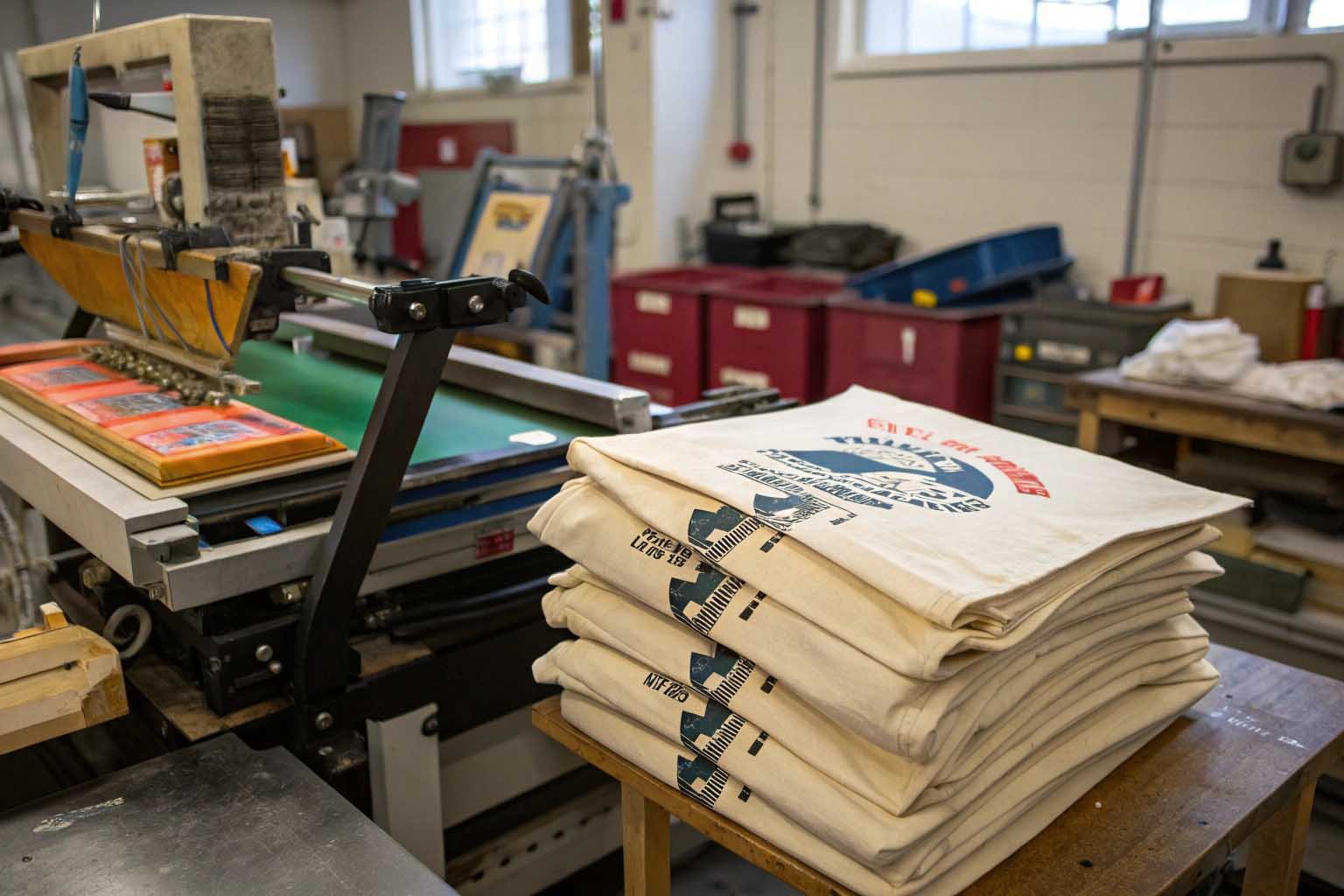
Not every business needs a massive run of bags, especially for targeted events or if you are a smaller company. Finding suppliers who understand this and offer flexibility with MOQs can be a game-changer. Our factory, Avecobaggie, was built on understanding these needs.
Specialized Promotional Product Suppliers
There are many companies out there that specialize in providing promotional items, including custom eco friedly exhibition tote bags. A good number of them have established networks of various manufacturers. Some of these suppliers are flexible enough to cater to lower MOQs, especially for standard items like basic 6-8oz cotton tote bags. They can often guide you through the available options, help with design, and manage the logistics of your order. They act as a helpful intermediary.
Online B2B Platforms
Websites such as Alibaba, Made-in-China, or even platforms like Etsy (if you are looking for very small, perhaps more artisanal or handcrafted orders) can connect you directly with manufacturers from around the world. On many of these platforms, you can filter your search by MOQ. However, it is very important to do your due diligence when vetting suppliers found this way. Communication can sometimes be a bit more challenging due to language barriers or time differences, and ensuring consistent quality control requires careful attention.
Directly from Small to Medium-Sized Factories
This is often a great route, and it is where businesses like mine, Avecobaggie.com, fit in. As someone who has been deeply immersed in the eco-friendly bag industry for over a decade, I have seen firsthand the diverse needs of businesses, particularly those that do not always require massive production quantities. Many smaller and medium-sized factories are more agile and often more willing to work with lower MOQs. This is especially true for simpler designs or when using readily available stock materials. For instance, I frequently recommend 6oz–8oz cotton or canvas tote bags to exhibitors because, with efficient production setups, we can often start production from as few as 100 pieces. This allows businesses to get high-quality, custom-branded bags without a huge upfront investment or excessive inventory.
Why Low MOQs Matter
Being able to order in lower quantities is fantastic for several reasons:
- Testing the Waters: If you are trying out a new bag style, a new design, or targeting a new audience segment, you probably do not want to commit to thousands of units right away. A lower MOQ allows you to test its effectiveness first.
- Targeted Campaigns: Perhaps you only need a specific number of bags for a small, exclusive event, a VIP gifting program, or a limited-time promotion. Distributing tote bags as incentives for specific actions, like attending a product demo or submitting contact information, can really boost engagement and lead generation, and you might only need a couple of hundred for this.
- Budget Constraints: Smaller businesses, startups, or companies with tighter marketing budgets can still benefit from the impact of custom-branded items when MOQs are accessible.
- Fresher Inventory & Design Flexibility: Ordering smaller batches more frequently means you can keep your designs fresh and respond to changing marketing themes or even create limited edition or numbered series tote bags. I’ve heard that limited editions can create a collection mentality, with some attendees being 68% more likely to seek out your booth to complete their set at future shows!
My primary goal with Avecobaggie is to empower businesses by sharing practical knowledge and insider insights. Part of that commitment is helping you find sustainable bag solutions that genuinely fit your actual needs and budget, not just trying to push for the largest possible order.
결론
The right trade show giveaway, especially a well-chosen and thoughtfully designed tote bag, significantly boosts your brand’s visibility and creates lasting positive impressions. Plan well, choose your materials and design wisely, and you will see maximum impact from your investment.


